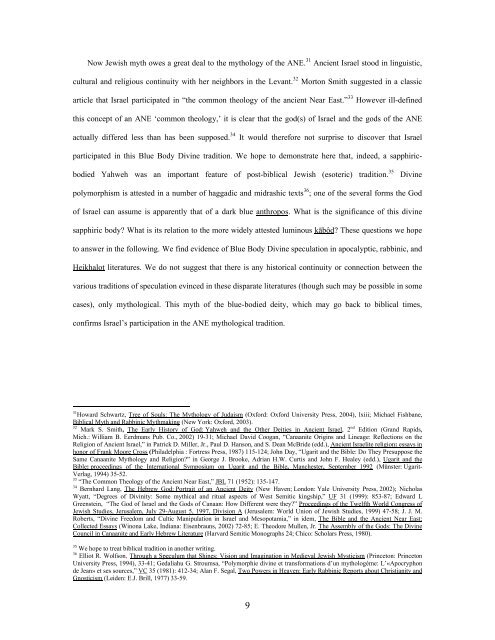Sapphiric God: - Dr. Wesley Muhammad
Sapphiric God: - Dr. Wesley Muhammad
Sapphiric God: - Dr. Wesley Muhammad
You also want an ePaper? Increase the reach of your titles
YUMPU automatically turns print PDFs into web optimized ePapers that Google loves.
Now Jewish myth owes a great deal to the mythology of the ANE. 31 Ancient Israel stood in linguistic,<br />
cultural and religious continuity with her neighbors in the Levant. 32 Morton Smith suggested in a classic<br />
article that Israel participated in “the common theology of the ancient Near East.” 33 However ill-defined<br />
this concept of an ANE ‘common theology,’ it is clear that the god(s) of Israel and the gods of the ANE<br />
actually differed less than has been supposed. 34 It would therefore not surprise to discover that Israel<br />
participated in this Blue Body Divine tradition. We hope to demonstrate here that, indeed, a sapphiric-<br />
bodied Yahweh was an important feature of post-biblical Jewish (esoteric) tradition. 35 Divine<br />
polymorphism is attested in a number of haggadic and midrashic texts 36 ; one of the several forms the <strong>God</strong><br />
of Israel can assume is apparently that of a dark blue anthropos. What is the significance of this divine<br />
sapphiric body? What is its relation to the more widely attested luminous kābôd? These questions we hope<br />
to answer in the following. We find evidence of Blue Body Divine speculation in apocalyptic, rabbinic, and<br />
Heikhalot literatures. We do not suggest that there is any historical continuity or connection between the<br />
various traditions of speculation evinced in these disparate literatures (though such may be possible in some<br />
cases), only mythological. This myth of the blue-bodied deity, which may go back to biblical times,<br />
confirms Israel’s participation in the ANE mythological tradition.<br />
31 Howard Schwartz, Tree of Souls: The Mythology of Judaism (Oxford: Oxford University Press, 2004), lxiii; Michael Fishbane,<br />
Biblical Myth and Rabbinic Mythmaking (New York: Oxford, 2003).<br />
32 Mark S. Smith, The Early History of <strong>God</strong>: Yahweh and the Other Deities in Ancient Israel, 2 nd Edition (Grand Rapids,<br />
Mich.: William B. Eerdmans Pub. Co., 2002) 19-31; Michael David Coogan, “Canaanite Origins and Lineage: Reflections on the<br />
Religion of Ancient Israel,” in Patrick D. Miller, Jr., Paul D. Hanson, and S. Dean McBride (edd.), Ancient Israelite religion: essays in<br />
honor of Frank Moore Cross (Philadelphia : Fortress Press, 1987) 115-124; John Day, “Ugarit and the Bible: Do They Presuppose the<br />
Same Canaanite Mythology and Religion?” in George J. Brooke, Adrian H.W. Curtis and John F. Healey (edd.), Ugarit and the<br />
Bible: proceedings of the International Symposium on Ugarit and the Bible, Manchester, September 1992 (Münster: Ugarit-<br />
Verlag, 1994) 35-52.<br />
33 “The Common Theology of the Ancient Near East,” JBL 71 (1952): 135-147.<br />
34 Bernhard Lang, The Hebrew <strong>God</strong>: Portrait of an Ancient Deity (New Haven; London: Yale University Press, 2002); Nicholas<br />
Wyatt, “Degrees of Divinity: Some mythical and ritual aspects of West Semitic kingship,” UF 31 (1999): 853-87; Edward L<br />
Greenstein, “The <strong>God</strong> of Israel and the <strong>God</strong>s of Canaan: How Different were they?” Proceedings of the Twelfth World Congress of<br />
Jewish Studies, Jerusalem, July 29-August 5, 1997, Division A (Jerusalem: World Union of Jewish Studies, 1999) 47-58; J. J. M.<br />
Roberts, “Divine Freedom and Cultic Manipulation in Israel and Mesopotamia,” in idem, The Bible and the Ancient Near East:<br />
Collected Essays (Winona Lake, Indiana: Eisenbrauns, 2002) 72-85; E. Theodore Mullen, Jr. The Assembly of the <strong>God</strong>s: The Divine<br />
Council in Canaanite and Early Hebrew Literature (Harvard Semitic Monographs 24; Chico: Scholars Press, 1980).<br />
35 We hope to treat biblical tradition in another writing.<br />
36 Elliot R. Wolfson, Through a Speculum that Shines: Vision and Imagination in Medieval Jewish Mysticism (Princeton: Princeton<br />
University Press, 1994), 33-41; Gedaliahu G. Stroumsa, “Polymorphie divine et transformations d’un mythologème: L’«Apocryphon<br />
de Jean» et ses sources,” VC 35 (1981): 412-34; Alan F. Segal, Two Powers in Heaven: Early Rabbinic Reports about Christianity and<br />
Gnosticism (Leiden: E.J. Brill, 1977) 33-59.<br />
9
















